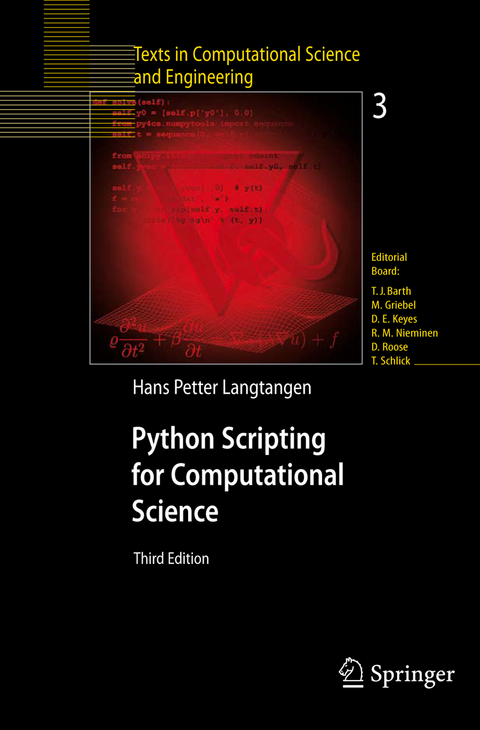
Python Scripting for Computational Science
Seiten
2010
|
3. Softcover reprint of hardcover 3rd ed. 2008
Springer Berlin (Verlag)
978-3-642-09315-9 (ISBN)
Springer Berlin (Verlag)
978-3-642-09315-9 (ISBN)
3rd edition
The goal of this book is to demonstrate how to develop tailored, flexible working environments built from small programs (scripts) written in the easy-to-learn, high-level language Python. The focus is on applications relevant to computational scientists.
Numerous readers of the second edition have noti?ed me about misprints and possible improvements of the text and the associated computer codes. The resulting modi?cations have been incorporated in this new edition and its accompanying software. The major change between the second and third editions, however, is caused by the new implementation of Numerical Python, now called numpy. The new numpy package encourages a slightly di?erent syntax compared to the old Numeric implementation, which was used in the previous editions. Since Numerical Python functionality appears in a lot of places in the book, there are hence a huge number of updates to the new suggested numpy syntax, especially in Chapters 4, 9, and 10. The second edition was based on Python version 2.3, while the third edition contains updates for version 2.5. Recent Python features, such as generator expressions (Chapter 8.9.4), Ctypes for interfacing shared libraries in C (Chapter 5.2.2), the with statement (Chapter 3.1.4), and the subprocess module for running external processes (Chapter 3.1.3) have been exempli?ed to make the reader aware of new tools. Chapter 4.4.4 is new and gives a taste of symbolic mathematics in Python.
The goal of this book is to demonstrate how to develop tailored, flexible working environments built from small programs (scripts) written in the easy-to-learn, high-level language Python. The focus is on applications relevant to computational scientists.
Numerous readers of the second edition have noti?ed me about misprints and possible improvements of the text and the associated computer codes. The resulting modi?cations have been incorporated in this new edition and its accompanying software. The major change between the second and third editions, however, is caused by the new implementation of Numerical Python, now called numpy. The new numpy package encourages a slightly di?erent syntax compared to the old Numeric implementation, which was used in the previous editions. Since Numerical Python functionality appears in a lot of places in the book, there are hence a huge number of updates to the new suggested numpy syntax, especially in Chapters 4, 9, and 10. The second edition was based on Python version 2.3, while the third edition contains updates for version 2.5. Recent Python features, such as generator expressions (Chapter 8.9.4), Ctypes for interfacing shared libraries in C (Chapter 5.2.2), the with statement (Chapter 3.1.4), and the subprocess module for running external processes (Chapter 3.1.3) have been exempli?ed to make the reader aware of new tools. Chapter 4.4.4 is new and gives a taste of symbolic mathematics in Python.
Getting Started with Python Scripting.- Basic Python.- Numerical Computing in Python.- Combining Python with Fortran, C, and C++.- to GUI Programming.- Web Interfaces and CGI Programming.- Advanced Python.- Fortran Programming with NumPy Arrays.- C and C++ Programming with NumPy Arrays.- More Advanced GUI Programming.- Tools and Examples.
From the reviews of the second edition:
"This book addresses primarily a CSE (computational science and engineering) audience. ... gives a clear and detailed account on the ways in which the surprisingly powerful Python language may aid the CSE community." (H. Muthsam, Monatshefte für Mathematik, Vol. 151 (4), 2007)
| Erscheint lt. Verlag | 22.11.2010 |
|---|---|
| Reihe/Serie | Texts in Computational Science and Engineering |
| Zusatzinfo | XXVI, 756 p. |
| Verlagsort | Berlin |
| Sprache | englisch |
| Maße | 155 x 235 mm |
| Gewicht | 1150 g |
| Themenwelt | Mathematik / Informatik ► Informatik |
| Mathematik / Informatik ► Mathematik ► Analysis | |
| Mathematik / Informatik ► Mathematik ► Angewandte Mathematik | |
| Schlagworte | C/C++ • computational experiments • Computational Science • C++ Programming • C programming language • C++ programming language • FORTRAN • gluing applications • graphical user interfaces • interfaces • language • multi-language programming • Open Source • programming • Python • Scientific Computing • Scripting • Simulation • Software • text processing • user interface • WINDOWS |
| ISBN-10 | 3-642-09315-9 / 3642093159 |
| ISBN-13 | 978-3-642-09315-9 / 9783642093159 |
| Zustand | Neuware |
| Informationen gemäß Produktsicherheitsverordnung (GPSR) | |
| Haben Sie eine Frage zum Produkt? |
Mehr entdecken
aus dem Bereich
aus dem Bereich
Schulbuch Klassen 7/8 (G9)
Buch | Hardcover (2015)
Klett (Verlag)
CHF 29,90


